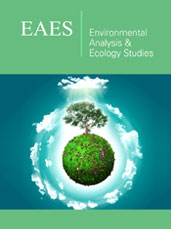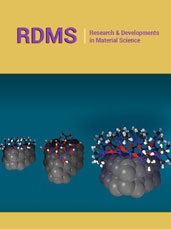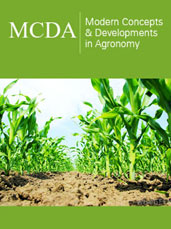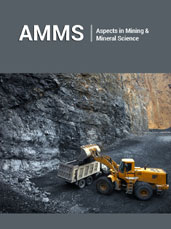- Submissions

Full Text
Environmental Analysis & Ecology Studies
Features of Heavy Metal Pollution of Urban Areas with Special Environmental Risks
Lisetskii Fedor*, Pizhevskii Nazar and Morabandza Kumu-Buya
Institute of Earth Sciences, Belgorod State National Research University, Russia
*Corresponding author:Lisetskii Fedor, Institute of Earth Sciences, Belgorod State National Research University, Russia
Submission: June 24, 2024; Published: July 16, 2024

ISSN 2578-0336 Volume12 Issue3
Abstract
The industrial functional zone of cities acts as a source of background technogenic dust, which not only creates environmental risks for highly sensitive population groups, but also becomes a permanent geochemical donor for technogenic surface formations. The study on the territory of a multifunctional city made it possible to compare the degree of pollution of surface formations with twelve heavy metals and metalloids with environmental standards using several approaches to the total assessment, as well as to assess the quality of anthropogenic urban substrates based on the content of macroelements and microelements. The results of assessing the degree of pollution of man-made surface formations in the urban ecosystem showed significant differences in approaches, in which the basis for comparison is the Maximum Permissible Concentration (MPC) or regional geochemical background. Pollution by pollutants, which is assessed by fixed and rarely updated values of concentrations of heavy metals and metalloids (MPC), does not provide an opportunity to take into account the soil-genetic and biogeochemical situation in specific soils. If, relative to MPC, excess concentrations are established only for four heavy metals (Pb, Cr, Zn, Fe), then, relative to the regional geochemical background, the list of increased concentrations of heavy metals is supplemented by Cu, Co, Sr, V, Mn, Ni, Ba. A direct correspondence between the potential fertility of urban surface formations (by the content of macro elements and microelements) and the degree of their pollution with heavy metals was not found.
Keywords:Man-made surface formations; Heavy metals; Urban pollution; Threats to children’s health
Introduction
The air basin of cities, along with organic and inorganic dust of natural origin, also contains artificial dust from synthetic products (wear of car tires, plastics, etc.), as well as inorganic dust (mineral and metal). The rate of dust settling is largely determined by the degree of dispersion, which is also important for hygienic assessment, since the depth of dust penetration into the respiratory tract depends on the particle size [1]. Background technogenic dust is present in the industrial functional zone of cities, but it contains one of the most dangerous types of air pollutants - fine suspended particles with an aerodynamic diameter of <10μm (PM10) and <2.5μm (PM2.5) [2]. Thus, studies in Belgorod showed that at a distance of 4km from emission high sources, about half of the suspended particle content is fractions 2.5-10μm and <2.5μm [3]. The size and geochemical composition of urban dust forms surface formations in certain functional zones of the city, which require special ecologically oriented studies. The relevance and research interest in this topic reflects the growth of publication activity, which is reflected in the Scopus database by the increase in the number of published articles for the phrase urban dust AND geochemistry from 2 to 8 times on average for 2008-2022 compared to the period 1970-2008.
An important component of urban ecosystems is urban soils, anthropogenic urban soils [4,5], which are reflected in different ways in soil classification, such as urbanozems, urbiquasizems, culturozems [6], can be supplemented by such specific objects as soil-like bodies. Urban pedogenesis is characterized by the dominance of the anthropogenic impact over the natural factors of soil formation, which determines the formation of specific soils and soil-like bodies (formations) [7]. Technogenic surface formations are residual products of urban life, which consist of natural and/ or specific newly formed substrate. Anthropogenic urban soils, which were part of the objects we studied, had a mixture of mineral material (sometimes with an admixture of organic matter) and specific anthropogenic inclusions in the form of residues of building materials, communications, road surfaces, etc. in the upper layer. As a result of the primary pedogenesis of urban soils under conditions of active input and interaction of pollutants with organic matter of soils, mechanisms of mobilization, migration and accumulation of Heavy Metals and Metalloids (HMM) in various geochemical environments are activated, and processes of biogeochemical transformation of organic compounds specific to the city occur, which largely determines the ecological state of anthropogenic urban soils.
The specificity of the conducted study was the comparative analysis of the levels of heavy metal contamination of the upper horizons of man-made surface formations from areas of intensive activity of the thermal power industry, transport infrastructure, as well as the vicinity of pre-schools to assess threats to children’s health. Ingestion of soil and dust are potential exposure routes for both children and adults. However, children are particularly susceptible to such exposure due to behavioral characteristics (e.g., a tendency to put objects or hands in their mouths, playing on the ground outdoors), which can increase their contact with soil and dust (Child-Specific Exposure Scenarios Examples: US EPA, 2014). Therefore, in risk management, it is crucial to determine the risk magnitude for specific highly exposed, highly sensitive or highly susceptible population groups. Soil and vegetation cover, swimming pools in the recreational area of pre-schools, provided that there are close background and impact sources of technogenic pollution, can be a receiver of NMs coming with aerosols. According to the report “State of Global Air 2024” [8], which was presented by the Health Effects Institute and the Institute for Health Metrics and Evaluation in partnership with the United Nations Children’s Fund- UNICEF, among the risk factors for death in children under five years of age, air pollution ranks second after malnutrition. The aim of the study was to conduct a comparative analysis of pollution of technogenic surface formations by the content of 12 heavy metals and metalloids in comparison with environmental standards and to identify the fertility potential through an integrated assessment of the content of macroelements and microelements (using the example of a multifunctional city).
Methodology
The object of this study is the city of Belgorod, the center of an agglomeration with a population of about 600 thousand people. The drivers of economic development of the agglomeration are industrial production in the field of power engineering, metalworking and radio electronics (20%) and construction (17%). The urban population density reaches 56 people per 1km2. The city territory is a typical urban landscape, where industrial areas, residential areas, buildings, road and railway networks are adjacent. The total number of man-made surface formations (n=12) (Figure 1) is distributed between three types of anthropogenic impacts: 1) near a thermal power plant and railways with active traffic (1, 2, 12); 2) road infrastructure (railways and roads) (3- 6, 8); 3) the vicinity of pre-schools (7, 9-11). The selection of technogenic surface formations or embryonic soil was carried out from the 0-5cm layer.
Figure 1:Location of sampling points in the city of Belgorod (the substrate is prepared for the online service World Imagery).

Eight of the 12 sites were located near railroad tracks (Figure 2 shows typical examples). Railroad dust is a potential source of metals and metalloids, Polycyclic Aromatic Hydrocarbons (PAHs) and other pollutants in the metropolitan environment. In particular, HMMs are released by abrasion of brake pads, wheels, rails, and PAHs are contained in creosote-impregnated sleepers [9]. The regional geochemical background (RGB) was based on the data on the upper soil layer (Greyic Phaeozems), which formed under the primary forest (a reserve within the city). The selection was made from the upper soil layer (10cm) between 4 aged oaks.
Figure 2:Examples of research objects in the city’s transport infrastructure zone.

The methodology of biogeochemical analysis of soils, which includes both the assessment of their pollution and resource potential in terms of potential fertility, was developed earlier [10] and used in this work. The content of chemical elements (12 HMM and 9 macroelements and microelements) was determined on an X-ray fluorescence spectrometer. Quantitative analysis of the gross content in the samples was carried out according to the method for measuring the mass fraction of metals and metal oxides in powder soil samples by the X-ray fluorescence method M-049-P/10 (FR.1.31.2011.09286). The method is approved for the purposes of state environmental control and monitoring (PND F 16.1.42-04). Using a set of State Standard Samples of Soil Composition, quantitative calibration of the results was performed. The geochemical composition of each sample was determined in two repetitions. If unacceptable discrepancies were found between the results of the first and second repetitions, which was detected in the spectrometer software “Spectroscan Max-GV”, we performed subsequent repetitions until an acceptable result was achieved. The results for each determined component obtained for the first and second working samples were averaged and their acceptability was checked by comparing the discrepancy with the permissible discrepancy - d (for a confidence probability of P 0.95).
The methods of integral assessment of soil pollution are well developed both in terms of methodology and in relation to various geoecological situations [11-17]. When assessing the degree of soil pollution with the main heavy metals, the MPC values adopted in ecology (standardized) were used, for iron the approximately permissible concentration in soils, and for barium the results of new studies [18]. Earlier [19], the admissibility of replacing the adopted MPC with more accurate estimates using the Regional Geochemical Background (RGB) was substantiated. Integral assessments of urban soil and sediment pollution by pollutants were obtained both by the average values of concentration coefficients, which were calculated relative to MPC or RGB (HMMPC and HMRGB, respectively), and by the Saet index [11], which takes into account the logarithmic law of biota response to the total impact of many factors. Generalized assessments of technogenic impact on surface sediments in the city were carried out by the total pollution index (Z) [11] using the formula:

where Кк is the concentration coefficient, was calculated relative to MPC or RGB; n is the number of elements taken into account.
In addition, a modification of the Saet index [11] was applied for comparison. This version of the equation does not take into account the logarithmic law:

The results of the integrated assessment of Soil Quality (SQ) were proposed [20] to be obtained by calculating the geometric mean content of the macroelements (P, K, Ca, Mg) and microelements (Zn, Mn, Fe, Ni, Cu) necessary for plants [21]. Our study was based on a specific natural and economic situation, therefore the integrated assessment of Soil Quality (SQ) was carried out by macroelements (SQ-1) and microelements (SQ-2). Plant nutrients were divided into essential macroelements (P, K, Mg, Ca, S) and essential microelements (Mn, Ni, Cu, Cl), with the exception of those whose average concentration exceeded the MPC level (Fe, Zn) in this data set. The classification similarity of objects was determined by interpreting the results of cluster analysis (Ward’s method, Euclidean distance, values are normalized by the standard deviation). We assessed statistically significant differences between contrast clusters using the Lowest Significant Difference (LSD) at a significance level of 1%.
Results
It was previously established that the most dangerous heavy metals in the industrial zone of the city, which over four decades can accumulate in concentrations exceeding the maximum permissible levels for soils, are lead, zinc, chromium, arsenic, copper and cobalt [22]. The results obtained in this study allow us to differentiate this conclusion in relation to various anthropogenic situations in the urban environment. The results presented in Table 1 showed that in these natural and technogenic conditions of urban ecosystems, the surface layer of man-made surface formations was distinguished by an excess of environmental standards and background values for lead, zinc, chromium and iron. These elements can be recognized as priority pollutants in organizing environmental monitoring of urban soils. Objects No. 4, 5 and 8 are characterized by a significant degree of HMM pollution, which is primarily determined by the excess of such pollutants as lead and iron over MPC, as well as zinc and arsenic (for object No. 8). Man-made surface formations have excesses over background values (RGB) for 11 out of 12 HM (except arsenic). Cluster analysis of chemical analysis data, which is a procedure for arranging objects into relatively homogeneous groups based on pairwise comparison of objects, was performed using the STATISTICA program (Figure 3).
Figure 3:Dendrogram of cluster analysis of 12 objects by HMM content (D is Threshold distance).

Table 1:Content of heavy metals and metalloids in man-made surface formations and their pollution assessments compared with MPC and RGB.

Note: Data are presented as the mean of two replicates with acceptable deviation at P<0.05. *approximately permissible concentration (the MAC level for iron has not been established).
Comparison of the mean values between the first and second clusters, the boundary between which is object No. 9, showed statistically significant differences, since the actual difference (d) is greater than the marginal error of the difference in means: d (169)>LSD (106) at P<0.01. The cluster, which includes more polluted objects, differs from the cluster with relatively “clean” objects by exceeding the concentrations of Pb, Sr, As (from 2 to 2.8 times) and Ni, Cu, Co, Zn (from 1.2 to 1.7 times). Objects No. 4 and 8, which are united by the cluster at a low level of unification, belong to the category of “highly hazardous” pollution. They are located near an industrial zone, a highway and railway tracks. The “borderline” nature of point No. 9 (pre-school No. 65) is explained by its location near a highway, due to which a significant excess of zinc is noted compared to relatively clean objects. The results of pH(H2O) determinations (Table 2) showed that the average value for the studied objects was 8, which corresponds to a moderately alkaline environment, with a maximum value at point No. 7 (8.2) and a minimum at point No. 1 (7.7). This indicator is used to assess the mobility of HM and is reflected in the standardization (taken into account in the MPC levels). Usually, the scales of environmental standardization of CHE are made for soils with a slightly alkaline and neutral reaction (pH 6.0-8.5) [23, p. 89]. In particular, according to the pH(H2O) data in Table 2, zinc may exhibit low mobility in the most polluted objects, which is indicative for objects No. 8, 5, 4, and copper (for object No. 5).
Table 2:Ranking of objects by total pollution level.

Notes: *** - highly hazardous; ** - moderately hazardous; * - permissible level of contamination.
The integrated pollution assessments of the objects differ greatly depending on the choice of comparison bases (MPC or RGB). Although the mathematical expectation of the pollution level even for one substance determines the environmental risk, summation even for a limited number of pollutants is incorrect and gives an overestimate of the level of environmental degradation [24]. On average, for 12 studied objects, the Z(1) value, which was calculated only taking into account four HMs (Fe, Cr, Zn, Pb), for which Kk> MPC, was 4 (the category of clean deposits); however, when using RGB, the Kk values were higher for 10 of the 12 elements (except Ba, As), and the overall Z(1) assessment was 33 (deposits with a high level of pollution). Among the 12 objects, three are distinguished by the highest degree of pollution relative to the MPC level: No. 8 (for Fe, Co, Zn, Pb, Ba, As) Z(1)=13 (deposits with a moderate level of pollution); No. 5 (for Fe, Cr, Co, Cu, Zn, Pb) Z(1)=7; No. 4 (for Fe, Cr, Zn, Pb) Z(1)=6. The three sampling points are located in different parts of the city, and it should be especially noted that point No. 8 is located 160 meters from pre-school No. 65. The significant values of the HMMPC and HMRGB indicators for zinc, both on average for the studied objects and especially in the most polluted places, are noteworthy. The current sanitary norms and rules do not regulate the zinc content in plant products, unlike other HM of the first hazard class (Pb, Cd, As, Hg) [25,26]. Soil quality assessment (SQ) for the content of macroelements and microelements (Table 3) is important for characterizing the level of potential fertility, which determines the possibilities of forming the vegetation cover, including in green urban economy.
Table 3:Plant nutrient content and integrated assessment of soil quality for macroelements (SQ-1) and microelements (SQ-2).

Note: Data are presented as the mean of two replicates with acceptable deviation at P<0.05.
Based on the average ranks of objects that have the best indicators for SQ-1 through SQ-2, the ranked series of the most favorable objects: 5>7>4>2 was formed. It is noteworthy that objects No. 4 and No. 5 are among the most polluted by HMM (both by the HMMPC indicator and by the HMRGB). While the remaining objects have excesses only over the average RGB indicators. Thus, the geochemical diversity of surface soils is manifested both in the high concentration of pollutants and in the content of chemical elements that can be actively involved in the biological cycle. Those objects that can be classified as relatively clean according to the integral assessment of pollution (No. 10, 9, 12, 11, 3) do not have a high fertility potential either in terms of the content of macroelements or in terms of the content of microelements. This indicates that there is no direct relationship between the resources of potential fertility and the levels of HMM pollution in urban ecosystems.
Conclusion
In general, the territory of the multifunctional city is characterized by an association of HM (Pb>Cr>Zn> Fe), the average concentrations of which exceed the MPC. For areas with the difficult environmental conditions (a moderately hazardous level relative to the MPC), the association of HMM priorities for monitoring has been established: Pb>Zn>Fe>Cr> As. A more rigorous assessment of pollution, which uses the RGB rather than the MPC as a basis, showed that the content of 11 out of 12 HM (except arsenic) in the surface formations of the city exceeds background indicators (Cu>Pb>Zn> (Co, Sr, Fe)> (V, Cr, Mn, Ni)> Ba). The general biogeochemical assessment of technogenic surface formations showed that there is no direct correspondence between the degree of their pollution by HMM and potential fertility resources (by the content of macroelements and microelements). Pollution assessed by rarely updated values of heavy metal and Metalloid Concentrations (MPC) does not allow taking into account the soilgenetic and biogeochemical situation in specific soils. If, relative to MPC, excess concentrations of four HM (Pb, Cr, Zn, Fe) are established, then, relative to the regional geochemical background, the list of increased HM concentrations is supplemented by Cu, Co, Sr, V, Mn, Ni, Ba. No direct correspondence was found between the potential fertility of urban surface formations (by the content of macroelements and microelements) and the degree of their pollution with HMМ.
References
- Klepikov OV, Kurolap SA, Prozhorina TI (2022) Carcinogenic risk to public health from air pollution in industrial cities of the central black earth region. AIP Conference Proceedings 2467(1): 080019.
- Borovlev AЕ, Zelenskaya EY (2018) Use of the air pollution summary calculations for industrial emission regulation in the city of Belgorod. Biogeosystem Technique 5(2): 149-158.
- Borovlev AE, Kornilov AG, Kiselev VV, Zelenskaya EY (2023) On the issue of assessing the dust pollution of the atmospheric air of the city of Belgorod. Regional Geosystems 47(4): 619-629.
- Craul PJ (1992) Urban soils in landscape design. John Wiley & Sons, Hoboken, New Jersey, USA, p. 396.
- Lehmann A, Stahr K (2007) Nature and significance of anthropogenic urban soils. Journal of Soils and Sediments 7(4): 247-260.
- Prokofeva TV, Gerasimova MI, Bezuglova OS, Bakhmatova KA, Goleva AA, et al. (2014) Inclusion of soils and soil-like bodies of urban territories into the Russian soil classification system. Eurasian Soil Science 47(10): 959-967.
- Murtazova K, Oboturova N (2023) Soils and man-made surface formations in urban landscapes. BIO Web of Conferences. EDP Sciences 63: 07002.
- Health Effects Institute (2024) State of global air 2024: Special report. Health Effects Institute, Boston, Massachusetts, USA.
- Kohler M, Künniger T (2003) Emissions of Polycyclic Aromatic Hydrocarbons (PAH) from creosoted railroad ties and their relevance for Life Cycle Assessment (LCA) Wood as A Raw Material and Working Material 61: 117-124.
- Lisetskii FN, Marinina OA, Smekalova TN (2016) Biogeochemical features of fallow lands in the steppe zone. Contemporary Problems of Ecology 9(3): 366-375.
- Saet YuE, Revich BA, Yanin EP (1990) Geochemistry of the environment. Mir Publishers, Moscow, Russia, p. 319.
- Zelenskaya EY, Marinina OA (2021) Geoecological assessment of soils in the main areas of viticulture of the Crimean Peninsula. Regional Geosystems 45(2): 258-268.
- Voloshenko IV, Novykh LL, Novykh EA (2022) Proposals for improving the list of soil characteristics during engineering and environmental surveys. Regional Geosystems 46(1): 132-142.
- Lazarev IS, Kochetova ZhYu, Maslova NV, Terentyev VV (2022) Integral assessment of soil pollution during airfield reconstruction. Regional Geosystems 46(3): 448-462.
- Yang S, Sun L, Sun Y, Song K, Qin Q, et al. (2023) Towards an integrated health risk assessment framework of soil heavy metals pollution: Theoretical basis, conceptual model, and perspectives. Environmental Pollution 316: 120596.
- Papadimou SG, Kantzou OD, Chartodiplomenou MA, Golia EE (2023) Urban soil pollution by heavy metals: effect of the lockdown during the period of COVID-19 on pollutant levels over a five-year study. Soil Systems 7(1): 28.
- Vodyanitskii YN (2010) Equations for assessing the total contamination of soils with heavy metals and metalloids. Eurasian Soil Science 43: 1184-1188.
- Semenkov I, Koroleva T (2020) Heavy metals content in soils of Western Siberia in relation to international soil quality standards. Geoderma Regional 21: e00283.
- Lisetskii FN, Zelenskaya EYA (2022) Differences in the content of heavy metals in the soils of the southern coast of Crimea (spatio-temporal analysis). Ecosistemy 34: 81-91.
- Yang T, Liu Q, Chan L, Cao G (2007) Magnetic investigation of heavy metals contamination in urban topsoils around the East Lake, Wuhan, China. Geophys J Int 171(2): 603-612.
- Bityutskiy NP (2011) Microelements of higher plants. SPB: Publishing House of St. Petersburg State University, Russia, p. 368.
- Lisetskii F (2022) Biogeochemical features of soil formation without parent rock in natural conditions and in an urban environment. IOP Conf Ser Earth Environ Sci 1010: 012018.
- Kirilyuk VP (2006) Microelements in the components of the biosphere of Moldova, Pontos, Chisinau, Moldova, p. 156.
- Kosinova II, Ignatenko IM, Bazarsky OV, Kuryshev AA, Budarina VA (2022) Use of a universal entropy model to assess the ecological state of the rural settlements territories. Regional Geosystems 46(4): 574-584.
- Anisimov VS, Anisimova LN, Frigidova LM, Dikarev DV, Frigidov RA, et al. (2015) Evaluation of migration ability of Zn in the soil-plant system. Biogeosystem Technique 4(2): 153-163.
- Lukin SV, Zhuikov DV (2021) Monitoring of the contents of manganese, zinc, and copper in soils and plants of the central Chernozemic region of Russia. Eurasian Soil Science 54 (1): 63-71.
© 2024 © Lisetskii Fedor. This is an open access article distributed under the terms of the Creative Commons Attribution License , which permits unrestricted use, distribution, and build upon your work non-commercially.
 a Creative Commons Attribution 4.0 International License. Based on a work at www.crimsonpublishers.com.
Best viewed in
a Creative Commons Attribution 4.0 International License. Based on a work at www.crimsonpublishers.com.
Best viewed in 







.jpg)






























 Editorial Board Registrations
Editorial Board Registrations Submit your Article
Submit your Article Refer a Friend
Refer a Friend Advertise With Us
Advertise With Us
.jpg)






.jpg)














.bmp)
.jpg)
.png)
.jpg)










.jpg)






.png)

.png)



.png)






